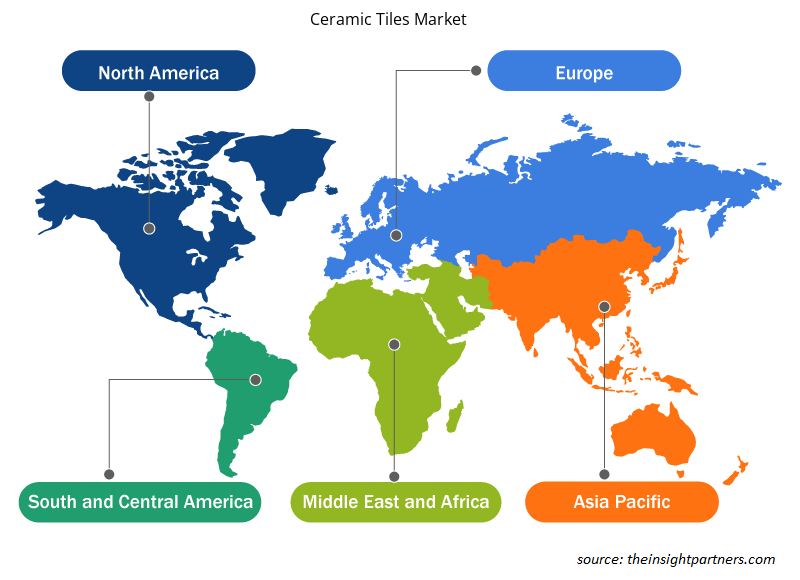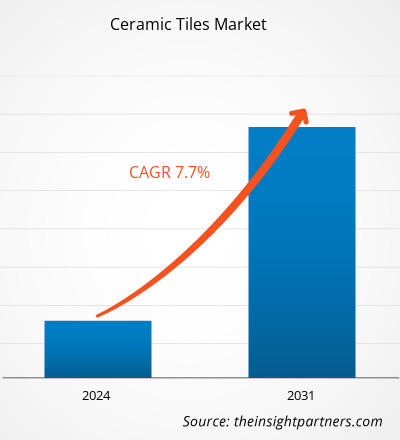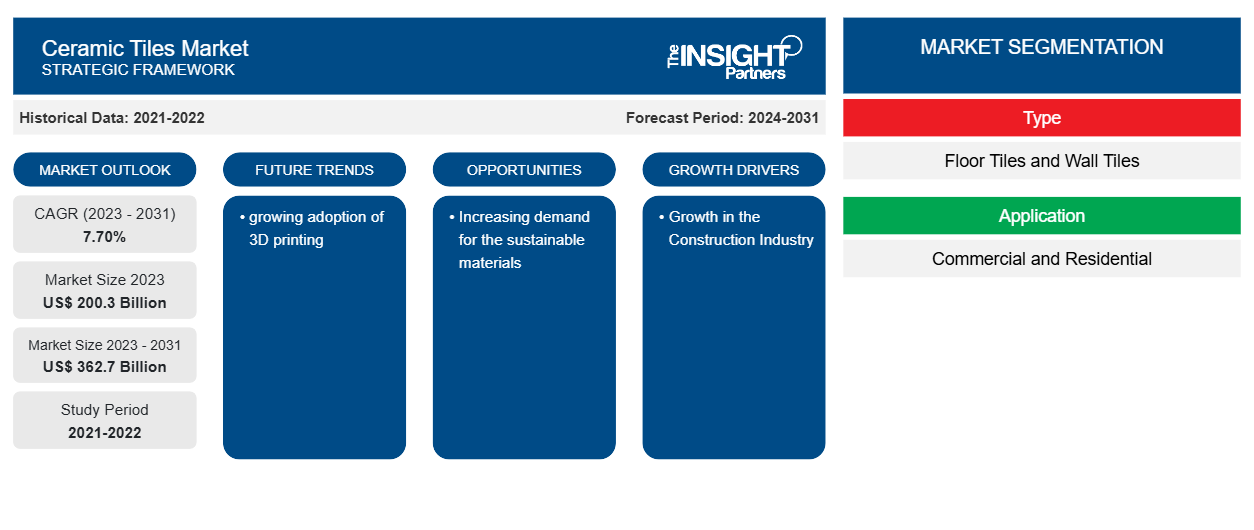Der Markt für Keramikfliesen soll von 200,3 Milliarden US-Dollar im Jahr 2023 auf 362,7 Milliarden US-Dollar im Jahr 2031 anwachsen. Der Markt soll in den Jahren 2023–2031 eine durchschnittliche jährliche Wachstumsrate (CAGR) von 7,70 % verzeichnen. Die kontinuierliche Nachfrage aus dem gewerblichen und privaten Sektor hat das Marktwachstum bei Keramikfliesen unterstützt. Darüber hinaus ist die zunehmende Bekanntheit und Einführung der 3D-Drucktechnologie im Keramiksektor einer der zukünftigen Trends in der Branche.
Marktanalyse für Keramikfliesen
Die Nachfrage nach keramischen Bodenfliesen wird voraussichtlich den größten Marktanteil ausmachen. Einige der wichtigsten treibenden Faktoren für die Einführung von keramischen Bodenfliesen sind niedrige Kosten, eine breitere Produktpalette und eine einfache Verlegung. Geografisch gesehen wird der globale Markt für Keramikfliesen vom asiatisch-pazifischen Raum dominiert. Die hohe Bevölkerungszahl und die wachsende Bauindustrie sind einige der Hauptfaktoren, die voraussichtlich den asiatischen Markt für Keramikfliesen dominieren werden. Darüber hinaus haben sich die Regierungen asiatischer Länder darauf konzentriert, ausländische Direktinvestitionen anzuziehen, um ihre kommerzielle Infrastruktur auszubauen. Solche Regierungsinitiativen unterstützen das Marktwachstum weiter.
Marktübersicht für Keramikfliesen
Keramikfliesen haben Natursteinprodukte aufgrund ihrer höheren Haltbarkeit und niedrigeren Preise deutlich ersetzt. Aufgrund ihrer Kosteneffizienz hat die Verwendung von Keramikfliesen in kostensensiblen Ländern wie China, Indien und einigen Ländern des Nahen Ostens zugenommen. Neben den oben genannten Faktoren sind Feuchtigkeitsbeständigkeit, Staubbeständigkeit und Belastbarkeit einige der anderen Eigenschaften, die das Marktwachstum weiter unterstützen. Die hohe Anzahl an Keramikfliesenherstellern in der Branche ist jedoch eine der Herausforderungen für den globalen Keramikfliesenmarkt. Darüber hinaus bietet die europäische Region aufgrund der gestiegenen Nachfrage nach ästhetischen Häusern in der Region auch lukrative Möglichkeiten für den Keramikfliesenmarkt. Darüber hinaus hat der Bausektor in Deutschland und Großbritannien in den letzten Jahren ein positives Wachstum gezeigt.
Passen Sie diesen Bericht Ihren Anforderungen an
Sie erhalten kostenlos individuelle Anpassungen an jedem Bericht, einschließlich Teilen dieses Berichts oder einer Analyse auf Länderebene, eines Excel-Datenpakets sowie tolle Angebote und Rabatte für Start-ups und Universitäten.
-
Holen Sie sich die wichtigsten Markttrends aus diesem Bericht.Dieses KOSTENLOSE Beispiel umfasst eine Datenanalyse von Markttrends bis hin zu Schätzungen und Prognosen.
Markttreiber und Chancen für Keramikfliesen
Wachstum in der Bauindustrie
Kontinuierlich wachsende Bevölkerung und Urbanisierung sind einige der Faktoren, die die Bauindustrie antreiben. Laut den Daten von Macrotrends im Jahr 2024 betrug die Weltbevölkerung im Jahr 2020 7,8 Milliarden; im Jahr 2022 erreichte die Zahl 8 Milliarden. Dies zeigt einen stetigen Anstieg der Bevölkerung. Darüber hinaus wird die Weltbevölkerung laut den Statistiken der Vereinten Nationen bis 2030 voraussichtlich 8,5 Milliarden erreichen. Ein Bevölkerungswachstum wird daher direkt die Nachfrage nach Wohn-, Gewerbe- und Infrastrukturbau erhöhen. Ein solcher Anstieg in der Bauindustrie hat die Nachfrage nach Keramikfliesen weiter erhöht und letztlich den Markt angetrieben.
Steigende Nachfrage nach nachhaltigen Materialien
Die Nachfrage nach umweltfreundlichen Materialien im Bausektor steigt aufgrund zunehmender Initiativen zur Reduzierung des CO2-Fußabdrucks rasant an. Strenge Vorschriften von Regierungen auf der ganzen Welt, insbesondere in den Industrieländern, zwingen Baustoffhersteller dazu, Produkte mit geringem CO2-Ausstoß herzustellen. Hersteller von Keramikfliesen in der Branche unternehmen umfangreiche Forschungs- und Entwicklungsaktivitäten, um Produkte mit geringem CO2-Fußabdruck auf den Markt zu bringen. Solche Aktivitäten werden voraussichtlich lukrative Möglichkeiten für den Markt für Keramikfliesen schaffen.
Segmentierungsanalyse des Marktberichts für Keramikfliesen
Wichtige Segmente, die zur Ableitung der Marktanalyse für Keramikfliesen beigetragen haben, sind Typ und Anwendung.
- Basierend auf dem Typ ist der Markt für Keramikfliesen in Bodenfliesen und Wandfliesen unterteilt. Das Segment Bodenfliesen hatte im Jahr 2023 einen größeren Marktanteil.
- Nach Anwendung ist der Markt in Gewerbe- und Wohnimmobilien segmentiert. Das Wohnimmobiliensegment hielt im Jahr 2023 den größten Marktanteil.
Marktanteilsanalyse für Keramikfliesen nach Geografie
Der geografische Umfang des Marktberichts für Keramikfliesen ist hauptsächlich in fünf Regionen unterteilt: Nordamerika, Asien-Pazifik, Europa, Naher Osten und Afrika sowie Südamerika/Süd- und Mittelamerika.
Der asiatisch-pazifische Raum hatte den größten Anteil am Weltmarkt. Einige der Faktoren, die die Nachfrage nach Keramikfliesen in der Region antreiben, sind die hohe Bevölkerungszahl und die Nachfrage nach kostengünstigen Produkten. Der asiatisch-pazifische Markt wird nach Ländern weiter unterteilt in Australien, China, Indien, Japan, Südkorea und den Rest des asiatisch-pazifischen Raums. Laut den Daten des Census and Economic Information Center aus dem Jahr 2022 verzeichnete der chinesische Bausektor im Jahr 2022 einen Umsatz von etwa 4 Milliarden US-Dollar, ein stetiges Wachstum gegenüber 2019. Diese Expansion des Bausektors wirkte sich direkt positiv auf den Bausektor aus. Abgesehen von China ergreift auch Indien einige aggressive Initiativen, um seinen Bausektor auszubauen. Das Pradhan Mantri Awas Yojana-Programm der indischen Regierung hat dazu beigetragen, dass die Wohnbaubranche deutlich gewachsen ist.
Regionale Einblicke in den Markt für Keramikfliesen
Die regionalen Trends und Faktoren, die den Markt für Keramikfliesen im Prognosezeitraum beeinflussen, wurden von den Analysten von Insight Partners ausführlich erläutert. In diesem Abschnitt werden auch die Marktsegmente und die Geografie für Keramikfliesen in Nordamerika, Europa, im asiatisch-pazifischen Raum, im Nahen Osten und Afrika sowie in Süd- und Mittelamerika erörtert.

- Holen Sie sich die regionalen Daten für den Keramikfliesenmarkt
Umfang des Marktberichts für Keramikfliesen
| Berichtsattribut | Details |
|---|---|
| Marktgröße im Jahr 2023 | 200,3 Milliarden US-Dollar |
| Marktgröße bis 2031 | 362,7 Milliarden US-Dollar |
| Globale CAGR (2023 - 2031) | 7,70 % |
| Historische Daten | 2021-2022 |
| Prognosezeitraum | 2024–2031 |
| Abgedeckte Segmente |
Nach Typ
|
| Abgedeckte Regionen und Länder |
Nordamerika
|
| Marktführer und wichtige Unternehmensprofile |
|
Marktteilnehmerdichte für Keramikfliesen: Auswirkungen auf die Geschäftsdynamik verstehen
Der Markt für Keramikfliesen wächst rasant, angetrieben durch die steigende Nachfrage der Endverbraucher aufgrund von Faktoren wie sich entwickelnden Verbraucherpräferenzen, technologischen Fortschritten und einem größeren Bewusstsein für die Vorteile des Produkts. Mit steigender Nachfrage erweitern Unternehmen ihr Angebot, entwickeln Innovationen, um die Bedürfnisse der Verbraucher zu erfüllen, und nutzen neue Trends, was das Marktwachstum weiter ankurbelt.
Die Marktteilnehmerdichte bezieht sich auf die Verteilung von Firmen oder Unternehmen, die in einem bestimmten Markt oder einer bestimmten Branche tätig sind. Sie gibt an, wie viele Wettbewerber (Marktteilnehmer) in einem bestimmten Marktraum im Verhältnis zu seiner Größe oder seinem gesamten Marktwert präsent sind.
Die wichtigsten auf dem Markt für Keramikfliesen tätigen Unternehmen sind:
- Mohawk Industries, Inc.
- China Keramik Co., Ltd.
- Weitere Informationen.
- GRUPO LAMOSA, SAB DE CV
- Kajaria Ceramics Limited
- Porcelanosa Grupo AIE
Haftungsausschluss : Die oben aufgeführten Unternehmen sind nicht in einer bestimmten Reihenfolge aufgeführt.

- Überblick über die wichtigsten Akteure auf dem Markt für Keramikfliesen
Neuigkeiten und aktuelle Entwicklungen zum Keramikfliesenmarkt
Der Markt für Keramikfliesen wird durch die Erhebung qualitativer und quantitativer Daten nach Primär- und Sekundärforschung bewertet, die wichtige Unternehmensveröffentlichungen, Verbandsdaten und Datenbanken umfasst. Im Folgenden finden Sie eine Liste der Entwicklungen auf dem Markt für Keramikfliesen und Strategien:
- Atlas Concorde stellte auf der Cersaie 2023 drei neue Kollektionen vor. Die Cersaie 2023 ist eine internationale Ausstellung für Keramikfliesen und Badezimmereinrichtungen. Atlas Concorde präsentierte während der Veranstaltung drei neue Kollektionen: Marvel Meraviglia, Boost Balance und Marvel Onyx. (Quelle: Atlas Concorde, Pressemitteilung/Unternehmenswebsite/Newsletter, 2023)
- Daltile hat sechs neue Fliesenkollektionen auf den Markt gebracht. Die Kollektion umfasst Artcrafted, Divinium, Acreage, Calgary, Pure und Gamma (Natural Stone). (Quelle: Daltile, Pressemitteilung/Unternehmenswebsite/Newsletter, 2023)
Marktbericht zu Keramikfliesen – Umfang und Ergebnisse
Der Bericht „Marktgröße und Prognose für Keramikfliesen (2021–2031)“ bietet eine detaillierte Analyse des Marktes, die die folgenden Bereiche abdeckt:
- Marktgröße und Prognose auf globaler, regionaler und Länderebene für alle wichtigen Marktsegmente, die im Rahmen des Projekts abgedeckt sind
- Marktdynamik wie Treiber, Beschränkungen und wichtige Chancen
- Wichtige Zukunftstrends
- Detaillierte PEST/Porters Five Forces- und SWOT-Analyse
- Globale und regionale Marktanalyse mit wichtigen Markttrends, wichtigen Akteuren, Vorschriften und aktuellen Marktentwicklungen
- Branchenlandschaft und Wettbewerbsanalyse, einschließlich Marktkonzentration, Heatmap-Analyse, prominenten Akteuren und aktuellen Entwicklungen
- Detaillierte Firmenprofile
- Historische Analyse (2 Jahre), Basisjahr, Prognose (7 Jahre) mit CAGR
- PEST- und SWOT-Analyse
- Marktgröße Wert/Volumen – Global, Regional, Land
- Branchen- und Wettbewerbslandschaft
- Excel-Datensatz
Aktuelle Berichte
Erfahrungsberichte
Grund zum Kauf
- Fundierte Entscheidungsfindung
- Marktdynamik verstehen
- Wettbewerbsanalyse
- Kundeneinblicke
- Marktprognosen
- Risikominimierung
- Strategische Planung
- Investitionsbegründung
- Identifizierung neuer Märkte
- Verbesserung von Marketingstrategien
- Steigerung der Betriebseffizienz
- Anpassung an regulatorische Trends























 Kostenlose Probe anfordern für - Markt für Keramikfliesen
Kostenlose Probe anfordern für - Markt für Keramikfliesen